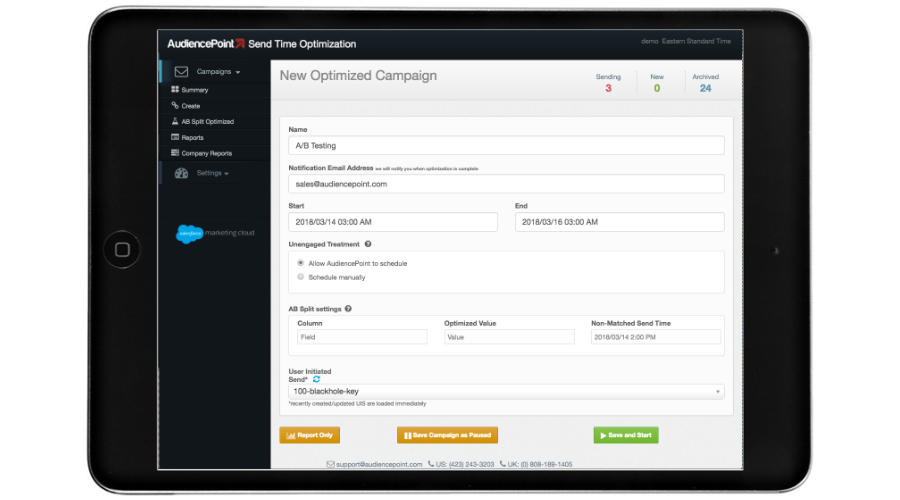AudiencePoint is thrilled to announce our new integration with Klaviyo! AudiencePoint is looking for partners to pilot our...
What Is the Biggest Challenge in Email Marketing?
When it comes to email marketing, the biggest challenge is not simply getting your emails delivered but ensuring they consistently land in your subscribers’ inboxes—otherwise known as inbox placement. Too many marketers focus solely on deliverability, only to realize that a successfully “delivered” email can just as easily end up in the spam folder as in the main inbox. This subtle but vital distinction is the crux of most email marketing challenges, as poor inbox placement can derail your entire campaign, lower engagement, and waste valuable marketing resources.
15 Email Marketing Challenges and How to Overcome Them: Deliverability vs. Inbox Placement
For years, the conversation centered around deliverability—whether the email reached the recipient’s mailbox at all. Deliverability also depends on the reliability of the chosen email service and the practices enforced by the email service provider, which monitor sender reputation, filter spam, and enforce standards to keep emails out of spam folders. However, what really moves the needle is where it lands after delivery. Even with high deliverability rates, if your messages end up in the promotions or spam folders, your audience is far less likely to see, open, or interact with your content. This is why knowing the best time to send marketing emails is critical—it can boost inbox visibility and improve engagement. This is where the true challenges of email marketing begin to emerge, and working with reputable email service providers is crucial for overcoming them.
Many email service providers use different algorithms and filtering techniques, which can impact inbox placement and the overall effectiveness of your campaigns.
The Importance of Email Landing in the Inbox—Not Just Being Delivered
Email clients constantly update their algorithms to filter out unwanted or irrelevant messages. Factors such as sender’s reputation—a key factor influencing inbox placement—list hygiene, and subscriber engagement now more heavily influence whether your carefully crafted email actually reaches the inbox. If you’re not vigilantly tracking inbox placement, you risk missing the mark—no matter how stellar your content or compelling your offer is.
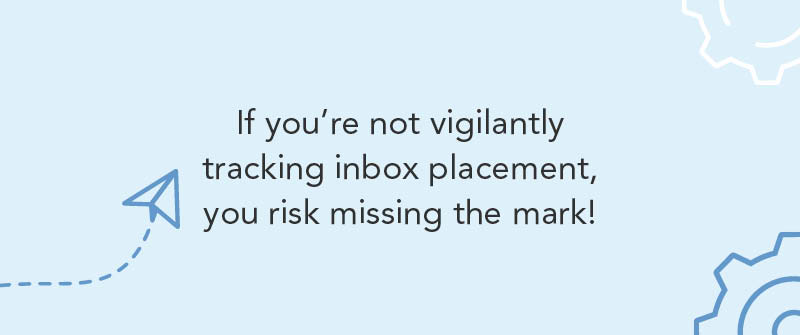
Why Poor Inbox Placement Undermines Email Marketing
Poor inbox placement sabotages your email marketing efforts in several ways: it reduces visibility, erodes sender reputation, and leads to lower engagement and conversion rates. Additionally, ongoing spam placement can trigger ISPs to further penalize your future sends, creating a downward spiral that erodes performance over time. For organizations that depend on email to drive revenue, these challenges aren’t just inconveniences—they threaten the bottom line.
Evolving Measurement: From Seed List and Panel Data to Advanced Inbox Placement Monitoring
Historically, marketers relied on unreliable seed list or panel data to gauge inbox placement, but these methods offered only partial, often skewed insights into deliverability. Recent advances—like the technology pioneered by AudiencePoint—now enable comprehensive, accurate monitoring of actual inbox placement across your entire audience. By analyzing real user engagement signals and comparing them to industry-wide benchmarks, modern tools allow marketers to collect data on real user engagement, which is essential for accurate inbox placement monitoring. These tools finally give you the visibility and actionable data you need to overcome these long-standing email challenges.
Types of Email Marketing and Their Unique Challenges
Email marketing has diversified into various types of email marketing, each offering unique ways for brands to connect with their audience while presenting distinct challenges. Understanding these differences is essential for marketers aiming to achieve maximum engagement, compliance, and ROI. From newsletters and promotional blasts to transactional notifications and sophisticated automated drip campaigns, each approach demands a tailored email marketing campaign strategy to navigate its complexities and reap the full benefits.
What Are the Major Types of Email Marketing?
The four primary email marketing types are newsletters, transactional emails, promotional campaigns, and automated (drip) emails. These marketing emails serve different purposes, from building engagement to driving sales and providing essential information. Newsletters deliver ongoing updates and curated content to subscribers, building consistent brand engagement. Promotional emails drive sales or specific actions through limited-time offers and product highlights. Transactional emails provide customers with order confirmations, shipping notifications, or account alerts—communications expected as a direct result of user actions. Finally, automated (drip) campaigns nurture prospects with a pre-planned sequence of messages triggered by subscriber behavior or milestones.
What Unique Challenges Come With Each Type of Email Marketing?
The challenges vary significantly by format. For newsletters, maintaining relevancy and resisting content fatigue requires diligent email segmentation and audience analysis. Promotional emails face deliverability risks due to higher send frequency and increased likelihood of being flagged as spam. Transactional emails must be reliable and timely—any delay or miss can erode customer trust and satisfaction. Automated drips, which depend heavily on behavioral triggers, demand careful journey mapping and constant optimization to prevent subscriber drop-off or disengagement. A robust email marketing strategy is essential to navigate these complexities and reap the full benefits of each type.
How Does Personalization Impact Different Types of Campaigns?
Personalization is vital but challenging, especially at scale. Leveraging accurate customer data is crucial for effective personalization and segmentation, as it enables better targeting and more relevant messaging. Newsletters and promotional emails benefit from dynamic content and tailored offers, but poor data hygiene or irrelevant messaging can backfire, resulting in higher opt-out rates. Transactional content must stay on-brand without sacrificing clarity or compliance. Drip campaigns see the greatest ROI when leveraging behavioral data, but they require robust tracking and adaptive logic—areas where many teams lack resources or the right technology.
What Are the Key Considerations for Aligning Content and Timing With Subscriber Expectations?
Subscribers expect emails that are relevant and timely, making list segmentation and send-time optimization critical. Strategically timing when you send emails is key to matching subscriber expectations and maximizing engagement. Inconsistent frequency, mismatched content, or missed lifecycle moments can quickly disengage your audience. For each type of email marketing, rigorously monitor campaign metrics, tune your content, and leverage automation to match individual journeys. Ultimately, overcoming these challenges relies on advanced email marketing tools—like those offered by AudiencePoint—that deliver actionable insights into engagement, deliverability, and inbox placement, empowering professionals to execute high-performance email strategies.
Why Deliverability and Inbox Placement Matter More Than Ever
In today’s hyper-competitive landscape, email deliverability and especially inbox placement have become non-negotiable components of successful email marketing. Despite the rise of evolving digital channels, email marketing remains one of the most effective ways to build customer relationships and drive business growth. It’s no longer enough for your campaigns to simply be delivered; what truly matters is whether they’re reaching your subscribers’ primary inboxes—where engagement and conversions actually happen. The distinction between “delivered” and “inboxed” cannot be overstated: a message sent to the spam folder counts as delivered, but it has no value to your business unless it is seen, read, and acted upon.
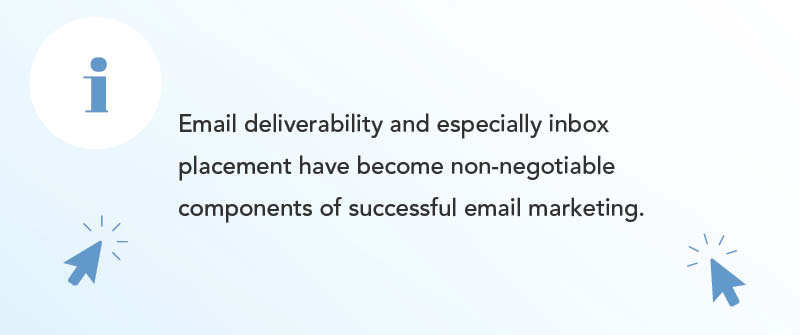
Delivered vs. Inboxed: What’s the Real Difference?
Let’s break down the difference. When an email is delivered, it has reached the recipient’s server—however, that could mean anywhere from the inbox to the spam or even the promotions folder. Ensuring your emails reach the primary inbox of your email recipients is essential for maximizing visibility and engagement. “Inbox placement” goes several layers deeper by measuring the percentage of delivered messages that actually land in the core inbox. In essence, it’s possible to have high deliverability and poor inbox placement if your messages are consistently flagged as spam or promotions. This insight is essential for marketing teams aiming for maximum visibility and action from their messages.
The Email Engagement Funnel: Unpacking the Journey
Consider the modern email engagement funnel: Send → Delivered → Inboxed → Open → Click. While deliverability used to be a key focus area, sophisticated marketers now understand that the real bottleneck often lies in inbox placement. If your message isn’t truly hitting the inbox, optimizing for opens and clicks is a wasted effort. Inbox placement serves as the gateway for down-funnel metrics, impacting everything from engagement rates to overall ROI. Improving inbox placement directly impacts click through rates, which are critical for measuring campaign success.
Unlocking ROI With Advanced Inbox Placement Monitoring
Accurate inbox placement monitoring is a game-changer for email marketers. Traditional methods such as seed lists and limited panel data samples often fall short—yielding only a partial picture and failing to surface problem areas in real time. Cutting-edge solutions, like those offered by AudiencePoint, leverage millions of real subscriber data points to accurately identify which emails are landing in spam, promotions, or primary inbox folders. This powerful visibility empowers marketers to quickly identify placement issues, take corrective action, and suppress addresses at risk, thus maintaining and even boosting sender reputation and engagement. Using a robust email marketing platform is essential for tracking inbox placement and optimizing deliverability.
The Bottom Line: Direct Impact on Performance and Revenue
The benefits of mastering inbox placement are immediate and tangible—increased engagement, reduced spam-related fallout, and, ultimately, elevated ROI. Marketers who invest in comprehensive inbox placement measurement see not only higher open and click rates but also more reliable revenue from their email programs. Insights gained from inbox placement measurement can be used to optimize future campaigns for even better results. In the age of precision marketing, tools like AudiencePoint are no longer optional—they are essential for staying ahead of the curve, safeguarding sender reputation, and making every campaign count.
How To Overcome Email Marketing Challenges
Improving email marketing performance and overcoming the complex challenges of this evolving channel require a committed, multifaceted strategy. Successful email marketing strategies require a combination of best practices, technology, and ongoing optimization. At the heart of success lies adopting email best practices—from mandatory list hygiene protocols to leveraging cutting-edge deliverability tools like AudiencePoint. When you systematically address each challenge, your email campaigns will not only reach your audience but also inspire action and engagement.
How To Improve Email Marketing Performance
Improving your email marketing performance is directly tied to your ability to consistently land in the primary inbox, drive opens, and foster clicks. Performance gains start with maintaining clean and healthy lists—a practice that eliminates inactive and bounced addresses, directly reducing the risk of spam placement and improving sender reputation. Furthermore, robust reputation management, such as leveraging authentication protocols like DKIM and SPF, keeping complaint rates low, and monitoring critical engagement signals, is fundamental to successful email programs. These pillars are non-negotiable for marketers striving to hit performance benchmarks in today’s landscape.
Taking things further, segmenting your lists and personalizing content can dramatically increase relevancy and response. Today’s sophisticated audiences expect emails tailored to their interests and behaviors. By implementing split testing, also known as A/B testing, on subject lines and content, marketers can continuously refine their approach based on real data rather than guesswork—translating to higher opens, clicks, and conversions over time. However, these tactics are only as effective as your ability to ensure actual inbox placement. Here, technologies like AudiencePoint become game-changers, giving marketers deep visibility into exactly where their emails land and actionable intelligence on how to improve results.
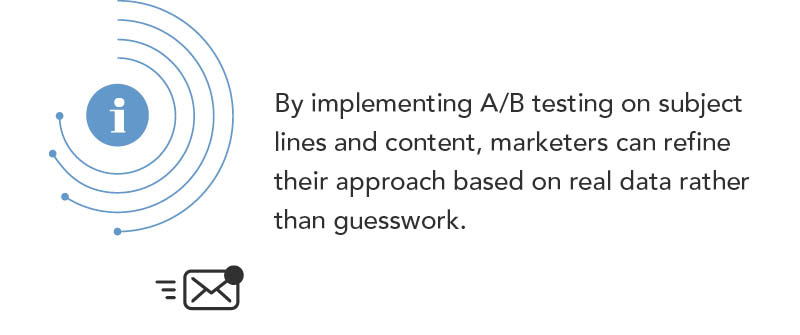
How Do You Overcome Email Marketing Challenges?
Overcoming email marketing challenges requires a blend of tactical discipline and strategic innovation. Start with list hygiene: schedule regular audits to remove or re-engage dormant addresses, and vigilantly purge hard bounces. Regularly identifying and removing inactive subscribers is crucial for maintaining list health and deliverability. This protects your sender reputation and focuses your campaigns on genuinely engaged recipients. Next, manage your reputation proactively by implementing sender authentication (SPF, DKIM, and DMARC), keeping your complaint rates to a minimum, and prioritizing the user experience to increase positive engagement signals.
Segmentation and personalization are vital for overcoming content fatigue among your subscribers. Move beyond basic demographic splits—leverage behavioral triggers, lifecycle stage, and engagement history to fuel relevant, timely messaging. Pair these efforts with constant experimentation; structured A/B testing should be part of your routine to nimbly adapt to subscriber preferences and shifting inbox algorithms.
The secret weapon for overcoming modern email challenges, however, is intelligent technology. Traditional metrics and outdated seed list monitoring can no longer keep pace with the complexity of inbox algorithms and user behaviors. That’s why more professionals are leaning on inbox placement tools like AudiencePoint. By monitoring subscriber-level signals and benchmarking against an unrivaled data pool, AudiencePoint empowers you to proactively address spam folder placement, suppress problematic addresses, and elevate deliverability.
Continuous Monitoring and Adjustment: The Key to Long-Term Success
Email marketing is not a set-it-and-forget-it endeavor. Continuous monitoring—informed by reliable tools and robust analytics—is essential for long-term optimization. With dynamic challenges like evolving ESP algorithms, changing audience habits, and rising privacy standards, you must be prepared to refine your tactics regularly. Ongoing adjustment and monitoring help ensure that future emails consistently achieve high deliverability and engagement. AudiencePoint’s real-time analytics make it easier than ever to move from insight to action. Imagine having irrefutable clarity about your true inbox placement instead of relying on guesswork or partial data. That is the path to continually outperforming your competition and demonstrating outstanding ROI.
In summary, if you want to improve your email marketing performance and conquer today’s most pressing email challenges, you must embrace list hygiene, reputation management, sophisticated segmentation, ongoing testing, and most importantly, state-of-the-art inbox placement measurement. AudiencePoint is the ultimate partner in this journey—arming you with the data and clarity needed to make every email count.
15 Common Email Marketing Challenges and Solutions
As email marketing professionals, we encounter a broad spectrum of email challenges—each with the potential to disrupt email performance. Optimizing your marketing campaigns is key to overcoming these common email marketing challenges. The key to overcoming these hurdles lies in identifying them early and implementing proven solutions. Below, we outline 15 of the most pressing challenges of email marketing and provide actionable strategies for overcoming each.
1. List Quality and Acquisition Issues
If your subscriber list is filled with low-quality or non-permission-based contacts, you’ll see poor engagement and higher bounce rates. Solution: Grow lists organically using sign up forms and double opt-in to attract subscribers who are genuinely interested in your content. Regularly remove inactive or invalid addresses, and avoid purchased or scraped lists. Monitoring unsubscribe rates can also help you identify issues with list quality and engagement.
2. Low Deliverability Rates
Emails that never reach the recipient are wasted opportunities. Solution: Authenticate your sender domain with domain based message authentication protocols such as the sender policy framework (SPF), DKIM, and DMARC, and ensure you properly configure the necessary DNS records. Continuously monitor bounce rates and use deliverability reporting tools to spot and fix issues early.
3. Spam Complaints and Blacklisting
High complaint rates hurt your reputation and can land your IP on blocklists. Solution: Set clear expectations at signup, make unsubscribing easy, and consistently deliver valuable, relevant content to your audience. Maintaining good list hygiene also helps you avoid spam traps—decoy email addresses used to catch unsolicited messages—and reduces the likelihood of your emails being flagged by spam filters, improving your deliverability.
4. Poor Inbox Placement
Email might be delivered but is filtered into the spam folder, unseen by your subscribers. Different email providers use varying filtering criteria, which can impact whether your emails reach the inbox or are sent to spam. Solution: Leverage advanced inbox placement tools like AudiencePoint to identify which subscribers are not seeing your emails in their inbox and suppress or re-engage those contacts with new tactics.
5. Low Open Rates
If subscribers don’t open your emails, your message is lost. Solution: A/B test subject lines, personalize at scale, send at optimal times, and segment your audience to ensure relevance. Crafting a compelling subject line is crucial—use short subject lines to quickly capture attention and avoid spam words to prevent your emails from being flagged, both of which can significantly increase open rates.
6. Low Click Rates
Opens without clicks signal your content or calls-to-action (CTAs) need work. Solution: Craft compelling CTAs, use visually attractive design, personalize offers, and ensure content matches subscriber interests. Including a clear call to action and tracking click through rates are essential for improving engagement.
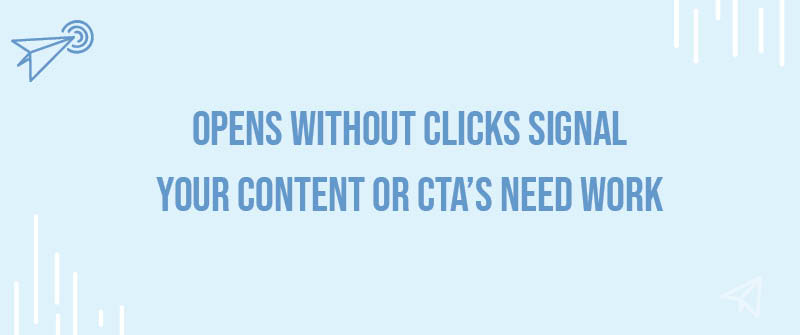
7. Content Relevancy and Design
Generic or unattractive emails fail to engage. Solution: Use dynamic content and personalized recommendations. Employ responsive, device-friendly email templates to ensure a seamless experience across platforms. Using well-designed email templates helps your emails display correctly on all devices and email clients, maintaining consistent branding and visual appeal.
8. Mobile Optimization
With most emails opened on mobile devices, poor mobile design frustrates users. Solution: Design with mobile-first in mind, keep layouts simple and fonts readable, and optimize images and buttons for touchscreens. Optimizing your emails for every mobile device and mobile phone is crucial for maximizing engagement.
9. Compliance (GDPR, CAN-SPAM)
Non-compliance can result in fines and reputation damage. Solution: Obtain clear consent, provide visible opt-out options, and honor data privacy rules. Regularly audit your processes to ensure ongoing compliance. Monitoring your unsubscribe rate also helps ensure compliance and maintain a healthy list.
10. Segmentation and Targeting
Sending the same message to everyone leads to irrelevance and disengagement. Solution: Understanding your target audience, segmenting your email subscribers, and focusing on existing customers are key to effective segmentation and targeting. Segment lists by demographics, behavior, or engagement level, and tailor content for each group using your ESP or AudiencePoint’s rich data insights.
11. Frequency and Send Timing
Too many or too few emails can hurt results. Solution: Analyze engagement data to optimize send frequency and timing, testing what works for different segments. This data-driven approach helps determine the best practices for sending emails to each segment, ensuring higher engagement and improved deliverability.
12. Resource Constraints (Content, Design, Tech)
Limited time or budget hinders high-quality campaign production. Solution: Streamline workflows with templates, automate campaigns where possible, and leverage third-party solutions like AudiencePoint for deeper analytics. Automation tools and most email marketing platforms offer features such as automated personalization, scheduling, and segmentation to further streamline campaign management and improve efficiency.
13. Keeping up With Evolving Email Platforms
ISPs and email clients constantly change their filtering algorithms and display capabilities. Solution: Stay informed on industry updates, test emails on every email client, manage incoming emails to build a good sender reputation, and avoid too many links in your content to maintain deliverability. Use adaptive technology that evolves with the landscape.
14. Tracking and Analytics Accuracy
Inaccurate reporting can mislead optimizations. Solution: Use analytics tools that correct for privacy and measurement changes, such as AudiencePoint’s subscriber-level panel data, for accurate insights into open, click, and inbox metrics. Robust email marketing programs enable you to analyze results, optimize future campaigns, and run effective re engagement campaigns to revive inactive subscribers and improve overall engagement.
15. Demonstrating ROI
Proving the value of email marketing to stakeholders can be difficult if attribution is unclear. Solution: Employ robust tracking across channels, integrate ESP data with CRM and commerce platforms, and use AudiencePoint for clear, data-driven reporting that ties inbox placement and engagement to revenue outcomes. Integrating email with your overall digital marketing strategy and consulting with a digital marketing consultant or marketing consultant can further help demonstrate ROI. Additionally, monitoring your domain reputation is essential for maintaining deliverability and proving the value of your email marketing efforts.
Why Marketers Need To Prioritize Inbox Placement Now
If you’re still measuring email marketing success by delivery rate alone, you’re missing a critical layer that could be undermining your results: inbox placement. It’s no longer enough for your emails to simply reach their destination server; what matters most is whether they land in your subscribers’ primary inbox or get lost in the depths of spam and promotions folders, never to be opened. Leveraging advanced email marketing platforms and optimizing your email marketing campaigns and email marketing efforts are key to maximizing engagement and ROI. For today’s competitive landscape, prioritizing inbox placement isn’t just an enhancement—it’s a must for forward-thinking email marketers committed to maximizing engagement, protecting sender reputation, and driving ROI.
Why Is Inbox Placement More Important Than Ever for Email Marketers?
With inbox filtering algorithms becoming ever more sophisticated, senders can no longer assume that a delivered message is a seen message. Monitoring the behavior of email senders and optimizing each email campaign are essential for increasing engagement and achieving better results. The difference between a message that’s merely delivered and one that’s inboxed has profound implications for campaign performance. When marketers overlook this crucial distinction, they sacrifice potential opens, clicks, and conversions without even realizing it. Those who closely monitor and act on inbox placement rates prove their commitment to deliverability best practices and ultimately glean a substantial advantage over the competition.
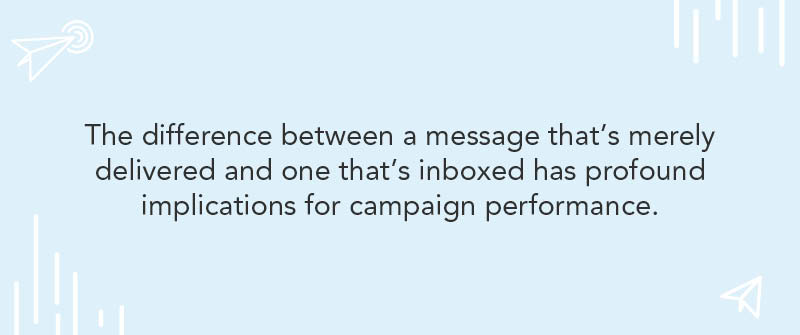
How Can Marketers Accurately Measure and Improve Inbox Placement?
Traditional methods like seed list and panel data were helpful starting points, but their limited, artificial samples fall short for today’s complexities. Modern technology—such as that provided by AudiencePoint—enables measurement at scale by analyzing real subscriber engagement data, not guesswork. With visibility into which subscribers are actually seeing your messages and which are consigned to spam, you gain clarity on your true inbox health and can take evidence-backed actions to fix issues at the root. More importantly, these insights allow you to continually optimize list hygiene, send timing, and content strategy, ensuring maximum relevance and minimizing risk.
Additionally, integrating landing pages and social media platforms into your strategy can help grow and engage your email list by capturing visitor information and building stronger relationships with your audience.
What Modern Tools Provide Actionable Inbox Placement Insights?
The latest generation of email marketing tools leaps beyond mere delivery metrics. AudiencePoint’s suite, for example, collects and synthesizes comprehensive inbox signals—from sends, opens, and clicks to bounces and unsubscribes—across an enormous, privacy-safe data pool. This depth of data means you get actionable, real-time guidance about where your emails truly land, who is (and isn’t) receiving them, and how to proactively address deliverability or reputation problems before they escalate. It empowers marketers to grow lists, boost engagement, and protect long-term sender health—without compromise. Offering incentives such as credits to your online store and utilizing a free tool can help grow your list, while remembering that email marketing remains a cornerstone of digital engagement.
Don’t let your campaigns fall short due to outdated measurement methods and missed inbox opportunities. Contact AudiencePoint and take charge of your email future: elevate your campaigns with innovative, data-driven inbox placement technology. With AudiencePoint, you gain unparalleled subscriber insights that transform deliverability into true engagement, ensuring your emails make an impact where it counts most—in your audience’s primary inbox.




